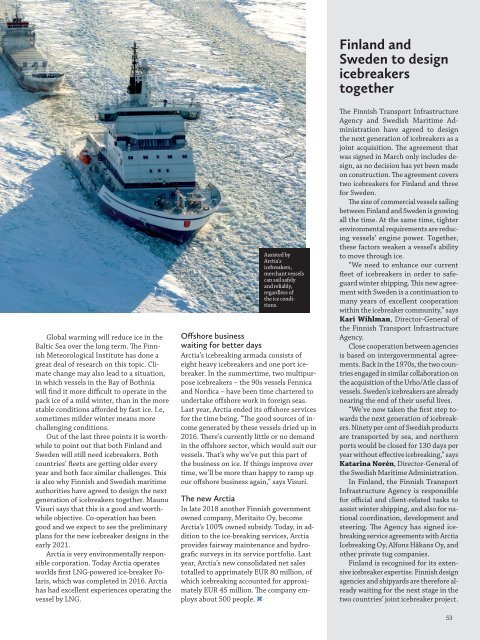You also want an ePaper? Increase the reach of your titles
YUMPU automatically turns print PDFs into web optimized ePapers that Google loves.
Finland and<br />
Sweden to design<br />
icebreakers<br />
together<br />
Global warming will reduce ice in the<br />
Baltic Sea over the long term. The <strong>Finnish</strong><br />
Meteorological Institute has done a<br />
great deal of research on this topic. Climate<br />
change may also lead to a situation,<br />
in which vessels in the Bay of Bothnia<br />
will find it more difficult to operate in the<br />
pack ice of a mild winter, than in the more<br />
stable conditions afforded by fast ice. I.e,<br />
sometimes milder winter means more<br />
challenging conditions.<br />
Out of the last three points it is worthwhile<br />
to point out that both Finland and<br />
Sweden will still need icebreakers. Both<br />
countries’ fleets are getting older every<br />
year and both face similar challenges. This<br />
is also why <strong>Finnish</strong> and Swedish maritime<br />
authorities have agreed to design the next<br />
generation of icebreakers together. Maunu<br />
Visuri says that this is a good and worthwhile<br />
objective. Co-operation has been<br />
good and we expect to see the preliminary<br />
plans for the new icebreaker designs in the<br />
early <strong>2021</strong>.<br />
Arctia is very environmentally responsible<br />
corporation. Today Arctia operates<br />
worlds first LNG-powered ice-breaker Polaris,<br />
which was completed in 2016. Arctia<br />
has had excellent experiences operating the<br />
vessel by LNG.<br />
Assisted by<br />
Arctia's<br />
icebreakers,<br />
merchant vessels<br />
can sail safely<br />
and reliably,<br />
regardless of<br />
the ice conditions.<br />
Offshore business<br />
waiting for better days<br />
Arctia’s icebreaking armada consists of<br />
eight heavy icebreakers and one port icebreaker.<br />
In the summertime, two multipurpose<br />
icebreakers – the 90s vessels Fennica<br />
and Nordica – have been time chartered to<br />
undertake offshore work in foreign seas.<br />
Last year, Arctia ended its offshore services<br />
for the time being. “The good sources of income<br />
generated by these vessels dried up in<br />
2016. There’s currently little or no demand<br />
in the offshore sector, which would suit our<br />
vessels. That’s why we’ve put this part of<br />
the business on ice. If things improve over<br />
time, we’ll be more than happy to ramp up<br />
our offshore business again,” says Visuri.<br />
The new Arctia<br />
In late 2018 another <strong>Finnish</strong> government<br />
owned company, Meritaito Oy, become<br />
Arctia’s 100% owned subsidy. Today, in addition<br />
to the ice-breaking services, Arctia<br />
provides fairway maintenance and hydrografic<br />
surveys in its service portfolio. Last<br />
year, Arctia’s new consolidated net sales<br />
totalled to apprimately EUR 80 million, of<br />
which icebreaking accounted for approximately<br />
EUR 45 million. The company employs<br />
about 500 people. ✖<br />
The <strong>Finnish</strong> Transport Infrastructure<br />
Agency and Swedish <strong>Maritime</strong> Administration<br />
have agreed to design<br />
the next generation of icebreakers as a<br />
joint acquisition. The agreement that<br />
was signed in March only includes design,<br />
as no decision has yet been made<br />
on construction. The agreement covers<br />
two icebreakers for Finland and three<br />
for Sweden.<br />
The size of commercial vessels sailing<br />
between Finland and Sweden is growing<br />
all the time. At the same time, tighter<br />
environmental requirements are reducing<br />
vessels’ engine power. Together,<br />
these factors weaken a vessel’s ability<br />
to move through ice.<br />
“We need to enhance our current<br />
fleet of icebreakers in order to safeguard<br />
winter shipping. This new agreement<br />
with Sweden is a continuation to<br />
many years of excellent cooperation<br />
within the icebreaker community,” says<br />
Kari Wihlman, Director-General of<br />
the <strong>Finnish</strong> Transport Infrastructure<br />
Agency.<br />
Close cooperation between agencies<br />
is based on intergovernmental agreements.<br />
Back in the 1970s, the two countries<br />
engaged in similar collaboration on<br />
the acquisition of the Urho/Atle class of<br />
vessels. Sweden’s icebreakers are already<br />
nearing the end of their useful lives.<br />
“We’ve now taken the first step towards<br />
the next generation of icebreakers.<br />
Ninety per cent of Swedish products<br />
are transported by sea, and northern<br />
ports would be closed for 130 days per<br />
year without effective icebreaking,” says<br />
Katarina Norén, Director-General of<br />
the Swedish <strong>Maritime</strong> Administration.<br />
In Finland, the <strong>Finnish</strong> Transport<br />
Infrastructure Agency is responsible<br />
for official and client-related tasks to<br />
assist winter shipping, and also for national<br />
coordination, development and<br />
steering. The Agency has signed icebreaking<br />
service agreements with Arctia<br />
Icebreaking Oy, Alfons Håkans Oy, and<br />
other private tug companies.<br />
Finland is recognised for its extensive<br />
icebreaker expertise. <strong>Finnish</strong> design<br />
agencies and shipyards are therefore already<br />
waiting for the next stage in the<br />
two countries’ joint icebreaker project.<br />
53

















